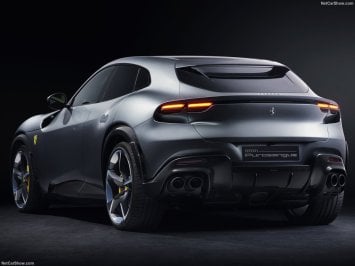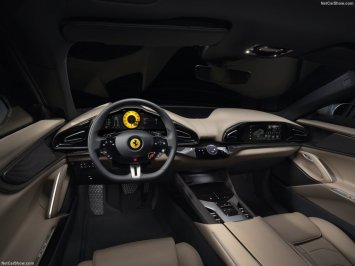Ferrari doesn't call it an SUV. In fact, it's at pains not to call it an SUV. So, officially the Ferrari Purosangue is a "four-door, four-seater." Powered by a front-mid-mounted 6.5-liter V-12 with 715 hp and 528 lb-ft, it’s capable of 0-62 mph in 3.2 seconds and a top speed of over 193 mph. The Purosangue features an 8-speed dual-clutch transaxle for a 49:51 weight distribution and borrows the unusual 4RM-S four-wheel drive system from the GTC4Lusso. These are all very good things. And that’s before we even get to the new active suspension system, four-wheel steering and the latest version of Ferrari’s magical Side Slip Control.
The sophisticated new Multimatic True Active Spool Valve (TASV) dampers are a key technology and vital to giving the Purosangue the agility, balance, and control expected of a Ferrari.
The ‘Ferrari active suspension technology’ system, using those dampers, combines powerful 48-volt electric motor actuation with precise spool valve technology. Each damper is fitted with its own electric motor, which can control the piston speed within the damper and finely tune roll stiffness in different phases of a corner. The system is so powerful that the Purosangue does not feature anti-roll bars. The ability to manipulate body control and decouple ride comfort from lateral stiffness sounds fascinating and like a potential game-changer. Expect to see these dampers used in future sports car iterations, too. Ferrari’s proprietary control logic combines the information from the suspension system’s accelerometers and position sensors with Side Slip Control 8.0 and the latest ABS-evo system.
There is no off-road setting on the Manettino. The Purosangue is not that sort of SUV. Instead, the driver can switch between Ice, Wet, Comfort, Sport, and ESC Off modes. As usual, this will alter the character of every element of the car from engine response to gearbox logic, suspension stiffness, traction and stability control thresholds, and e-differential locking characteristics. It will also change the characteristics of the four-wheel drive system. As mentioned before this is a development of the 4RM-S system as seen on the GTC4 Lusso. The front and rear axles have no physical connection. A two-speed gearbox or PTU (Power Transfer Unit) is hung from the front of the engine and takes power directly from the crank. As in the Lusso, the Purosangue won’t have four-wheel-drive capability above 5th gear.
It’s six inches shorter than a Urus Performante, almost identical in terms of width and wheelbase and the roofline is around an inch lower. It seems strange talking about trunk capacity in terms of a Ferrari but the Purosangue’s is adequate rather than outstanding. For context, the Lamborghini, already a compromised SUV shape, has 21.75 cubic feet of space as compared to the Ferrari’s 16.7 cubic feet. The new Range Rover has over double the capacity
The body itself is made up of a mix of aluminum and carbon fiber–including the roof–with high-strength steel used for the intrusion bars and B-pillars. Ferrari claims the Purosangue weighs 4482 pounds, but that’s a dry weight and assumes the owner has ticked all the boxes for lightweight options. The size and mass of the Purosangue make the suspension system all the more impressive and intriguing. Ferrari has also employed the latest independent four-wheel steering system as seen on the 812 Competizione.
Expect the Purosangue to cost circa $400,000 before you start adding lightweight options or delving into the endless Atelier customization program. The SUV will make up no more than 20 percent of Ferrari production annually.









